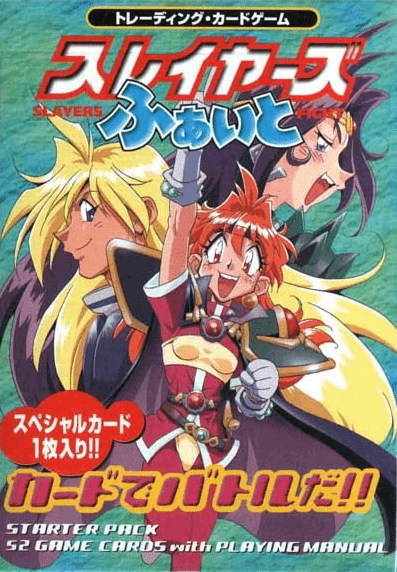
Slayers Fight (1999)
2 - 2 persone
20 - 60 min
0+
Al momento questo prodotto non è disponibile presso nessun venditore.
Artisti: u7fa9u4ef2u7fd4u5b50 (Yoshinaka Shouko), u3042u3089u3044u305au307f u308bu3044 (Rui Araizumi), u5927u585a u30c8u30df (Tommy Ohtsuka)
Descrizione: Lina: “Listen and be amazed! Slayers has a TCG now!”
Amelia: "Oooh! That world’s strongest, unbeatable, survival hobby that even the neighborhood elderly women regard highly, that TCG right!"
Slayers Fight (Japanese: スレイヤーズふぁいと Romaji: sureiyāzu faito) was a trading card game (or TCG). Cards are categorized as basic, common, uncommon, rare, and special. Players collect cards and build decks out of their collection.
Players build a deck of cards and duel against an opponent's deck. Players are wizards attempting to reduce their opponent's life total to zero. The first player to score 10 or more points (or meet another set win condition) wins the game. Points are earned by fullfilling your clients needs, deveating your opponent's characters or attacking their client.
An important part of the game is deck construction, which is done prior to the actual game by selecting what cards are included in a particular deck. There are over 452 different cards from which to build your deck!
Cards can be clients, which usually generates resources of various types, while characters and events require a certain amount of resources to be used. Incantation cards require characters with enough magical aptitude to chant their incantations before they can be resolved. Attack support cards can be utilized by characters with certain characteristics. Some cards (clients, characters, and subcategories of the other card types) stay on the board and continue to affect the game, while others have a one-time effect.
Players start with their chosen client and randomly draw cards to see what they get and can play each turn. Although this limits your choices, there is a lot of strategy in how you play those cards. A robust list of game mechanics, including intricate rules for reactive card play provide for rich tactics and tough choices each turn.
Though traditionally a two-player duel, there are casual formats that allow more players to play.
Amelia: "Oooh! That world’s strongest, unbeatable, survival hobby that even the neighborhood elderly women regard highly, that TCG right!"
Slayers Fight (Japanese: スレイヤーズふぁいと Romaji: sureiyāzu faito) was a trading card game (or TCG). Cards are categorized as basic, common, uncommon, rare, and special. Players collect cards and build decks out of their collection.
Players build a deck of cards and duel against an opponent's deck. Players are wizards attempting to reduce their opponent's life total to zero. The first player to score 10 or more points (or meet another set win condition) wins the game. Points are earned by fullfilling your clients needs, deveating your opponent's characters or attacking their client.
An important part of the game is deck construction, which is done prior to the actual game by selecting what cards are included in a particular deck. There are over 452 different cards from which to build your deck!
Cards can be clients, which usually generates resources of various types, while characters and events require a certain amount of resources to be used. Incantation cards require characters with enough magical aptitude to chant their incantations before they can be resolved. Attack support cards can be utilized by characters with certain characteristics. Some cards (clients, characters, and subcategories of the other card types) stay on the board and continue to affect the game, while others have a one-time effect.
Players start with their chosen client and randomly draw cards to see what they get and can play each turn. Although this limits your choices, there is a lot of strategy in how you play those cards. A robust list of game mechanics, including intricate rules for reactive card play provide for rich tactics and tough choices each turn.
Though traditionally a two-player duel, there are casual formats that allow more players to play.
